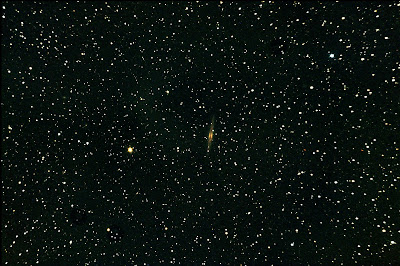M42
 The long exposure time brings out the nebula's dust lanes and inner structure. Note the contrasting colors in the Running Man Nebula (upper right of image).
The long exposure time brings out the nebula's dust lanes and inner structure. Note the contrasting colors in the Running Man Nebula (upper right of image). NGC 2264 - The Cone Nebula & Christmas Tree Cluster
The Cone Nebula, first noticed by William Herschel in 1785, is a combination of overlapping absorption (dark) and emission (bright) nebulae, which give the nebula complex its unique shape. The nebula is associated with a cluster of young, bright stars, often referred to as the Christmas Tree Cluster. Both lie about 2,700 light years away.
The image below captures both the Cone Nebula (center left) and Christmas Tree Cluster (center right) amid a particular rich starfield. Note the waves of nebulosity in the upper right part of the image.

IC 434 - The Horsehead Nebula
Like M42, the Horsehead Nebula demands repeated attention, and very long exposures to draw out all of its hidden detail. The image below combines sub-exposures taken on September 19, November 28 and December 9, for a total of 196 minutes.
 M97 - The Owl Nebula & M108
M97 - The Owl Nebula & M108 The above image had an total exposure time of about one hour.
The above image had an total exposure time of about one hour.
NGC 2237 & 2244 - The Rosette Nebula & Cluster
Given the wonderful complexity of this nebula in Monoceros (the Unicorn), I figured it would benefit from additional exposure time. The image below combines 35, 300-second sub-exposures taken on October 18 and December 16, for a total exposure time of 175 minutes (almost three hours).
The Crab Nebula is the result of a supernova (the explosive death of a large star) that was observed on Earth, as a suddenly appearing bright star, in 1054. The nebula appears in the constellation Taurus (The Bull) and lies about 6,500 light years away and contains the Crab Pulsar, a rapidly rotating neutron star that releases radiation in frantic pulses. The pulsar is all that remains of the massive star whose death gave birth to the nebula. The Crab Pulsar was the first pulsar so identified by radio astronomers.
The image below shows M1 in its starfield.
 In order to better show the nebula's structure, I have cropped the image to highlight the nebula itself.
In order to better show the nebula's structure, I have cropped the image to highlight the nebula itself.
 Both images comprise 20, 300-second images take on October 25 and December 16, for a total exposure time of 100 minutes.
Both images comprise 20, 300-second images take on October 25 and December 16, for a total exposure time of 100 minutes.











































